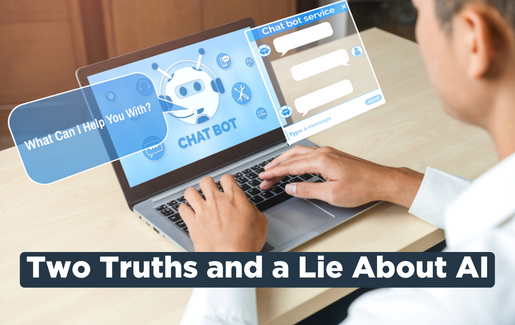
ChatGPT is the new kid in school. And it comes from a family that we’ve all heard of but remains a bit mysterious – artificial intelligence (AI). On a recent Volley podcast episode, Two Truths and a Lie About AI, CompTIA researchers Carolyn April and Seth Robinson chat with Mechie Nkengala, CEO and chief data scientist, Data Products LLC and vice chair of CompTIA’s AI Advisory Council. The three engage in an icebreaker of sorts with AI to dive into a broader discussion about how AI can drive business outcomes and the value of good data within an organization.
Getting To Know AI
Not too long ago, AI image generation tools were creating a buzz. Now, it’s tools like ChatGPT making the headlines. Large language learning models (LLM) are at the root of these trends. While AI was considered more of an emerging technology pre-LLM, the advancement of LLM has made conversing with AI more streamlined.
Of course, business executives want to get on board. Companies worldwide are asking how they can leverage AI to drive efficiency. But there are limitations. Let’s break the ice and get to know AI a little bit better with two truths and a lie.
AI Truth #1
AI is an enabling technology that can drive strategic business goals.
At a fundamental level, AI is an enabling technology. Meaning that you can’t procure AI, plug it in and reap the benefits. In order to get the most out of AI technology, you have to know what your business objective is.
“In terms of business, AI can help us drive efficiency,” said Nkengala. “But it’s not a futuristic, fantastical thing that will magically make everything better. You have to get back to the business. Ask yourself what are your main problems? Then let the solutions to those problems be driven by something that’s analytical and innovative versus leveraging AI for the sake of it.”
Nkengala added that AI technology isn’t cheap, and the cost of the solution should be worth it. Robinson agreed, noting that if you don’t know the ins and outs of your business objective, then AI might not be as useful.
Furthermore, providers should realize that AI isn’t a product that can be sold and should be thought of as a tool that provides value as a component of other applications.
“If you are a company in the channel that wants to get into AI as a business, it’s not about checking a box but more about understanding the customer’s business outcome. It all has to be linked together,” April said.
AI Truth #2
Good AI results from using good data.
If you don’t have your data in order, it makes it tough to have AI that works properly. Let’s revisit ChatGPT for a moment. While ChatGPT can produce satisfactory results, it does not create original content. LLMs reorganize, summarize, translate, predict and generate text and other knowledge based on a very large data set.
“LLMs are based on learning a very large body of knowledge,” Nkengala said. “If we have garbage in that body of knowledge, garbage will be produced.”
And that may be a problem for many companies. “One of the key problems you’ll find in organizations is data quality. Creating a solid foundation for collecting and cleaning the right data is important,” Nkengala added.
But good data doesn’t end with quality – it’s about representation as well.
“We’re aware that most people that code are in a certain demographic,” Nkengala said. “That limits a huge part of the population. What the AI system learns is not representative of the entire world, but just a portion of it. This can have a myriad impact on social or political policy programs and decisions when it comes to healthcare.”
The Lie
AI will eliminate jobs across the economy.
This isn’t the first time in history we’ve been hesitant about robots coming for our jobs. There is, in fact, a long history of how technology disrupts the workforce. But that history of disruption usually results in workforce growth.
“As the appetite for output grows, the need to optimize the outputs grow,” Robinson said. “That’s especially true for AI. AI works on probability. It will always give you the likely answer. In many cases, that likely answer is good enough. But as the desire for quality grows, we’re going to need people working with the data and looking at the outputs and people that can take the output and do something else with it.”
There will be new skills and new jobs, and there will also be some jobs that go away. But the experts agree that it’s a bit hasty to say that AI will wipe out huge swaths of jobs.
“Change is the only thing that we are sure is constant,” Nkengala said. “Jobs just don’t disappear – they morph. The idea is to position yourself in a way that you can roll with the tide.”
That means learning new skills and spending your time and energy where you’re truly needed as opposed to engaging in repetitive tasks that a machine could do more efficiently. Nkengala’s advice is to think about how you can use your brain and build something that your insights create.
Think About How AI Can Help, Not Hurt
The best way to think about AI is as an enabling technology that can drive strategic goals, and it's important to recognize that good AI output means good data input. As for the lie, the headlines around AI wiping out jobs aren't in line with historical trends around technology innovation. There will be disruption, but AI is more likely to create and change existing jobs that use new skills to do new things. Don’t jump into AI because it’s a trendy buzz word. Instead, take the time to ask the right questions to understand exactly how AI technology can help your business instead of hurting it.

 Add CompTIA to your favorite RSS reader
Add CompTIA to your favorite RSS reader

